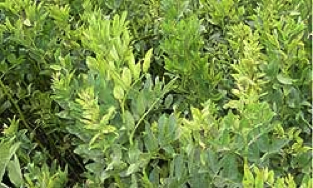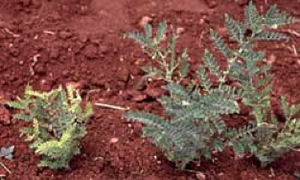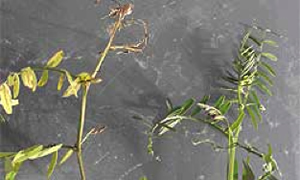Temperate pulse viruses: bean leafroll virus
 Bean leafroll virus (BLRV), also known as pea leafroll virus, is distributed worldwide but was not reported in Australia until 1999.
Bean leafroll virus (BLRV), also known as pea leafroll virus, is distributed worldwide but was not reported in Australia until 1999.
The virus is transmitted by aphids in a persistent manner but not through inoculation of sap or through seed.
Virus infected legume plants show yellowing, leaf rolling and significant reduction in pod setting. Yield losses of 50 to 90 per cent have been reported in Europe.
The natural host range is limited to the Fabaceae family.
The virus infection may be minimised by early spraying for aphids. Other control measures include sowing virus resistant varieties, aphid monitoring and spraying and eradication of virus source plants.
What to look for
The general symptoms of BLRV on pulses are:
- interveinal chlorosis
- yellowing
- stunting
- leaf rolling.
These symptoms could easily be confused with subterranean clover stunt virus (SCSV) or other luteoviruses such as beet western yellows virus (BWYV) and subterranean clover red leaf virus (SCRLV) or nutrient stress symptoms.
Symptoms on specific crops are:
- faba beans develop interveinal yellowing, top yellowing, upward rolling of leaves and stunting of plants
- lentils develop yellowing, small leaves and stunting of plant
- chickpeas develop yellowing and stunting of plants
- vetch develops yellow leaves and tip necrosis
- lucerne is usually symptomless but bright yellow vein clearing may be associated with infection
- field peas develop stunting, yellowing of young leaf tips, and sometimes downward leaf rolling
- sub-clover and crimson clover develop interveinal yellowing followed by reddening at margins of older leaves
- white clover develops yellowing, reddening and rolling of leaves.
Disease cycle
Transmission
BLRV is transmitted by several aphid species in a persistent manner. It is not transmitted mechanically and not through seed.
Pea aphid (Acyrthosiphon pisum) is the principal vector of BLRV. The following species are also reported as vectors of BLRV:
- foxglove aphid (Aulacorthum. solani)
- cowpea aphid (Aphis craccivora)
- black bean aphid (Aphis fabae) (not found in Australia)
- cotton aphid (Aphis gossypii)
- potato aphid (Macrosiphum euphorbiae)
- vetch aphid (Megoura viciae)
- green peach aphid (Myzus persicae).
In surveys the two most common aphid vectors of BLRV found on faba bean, vetch and lentil are cowpea aphid (Aphis craccivora) and green peach aphid (Myzus persicae).
Host range
The natural host range of BLRV is limited to the Fabaceae family.
It infects temperate pulses (faba bean, field pea, chickpea, lentil, vetch), other legumes (soybean, sweet pea, French bean, cowpea) and pastures (lucerne, white clover, red clover and subterranean clover).
In experiments BLRV is transmitted to 3 of 17 non-legume hosts (Ashby 1984).
Economic importance
In Europe 50 to 90 per cent yield losses have been reported (Heathcote and Gibbs 1962). In NSW up to 37 per cent incidence of BLRV has been reported on faba beans (Van Leur et al. 2002).
Surveys of pulse crops in the last 10 years indicate that BLRV is an important virus of faba bean and field pea crops in south eastern Australia.
Table 1: Percentage of pulse crops infected with bean leafroll virus in south eastern Australia and within crop virus incidence
Victoria – Lentil
Year | % of sampled crops infected | Within crop virus incidence range % |
|---|---|---|
2004 | 16 | 1 to 2 |
2006 | Crop not sampled/tested | Crop not sampled/tested |
2007 | 38 | 1 to 2 |
2009 | Crop not sampled/tested | Crop not sampled/tested |
Victoria – Fababean
Year | % of sampled crops infected | Within crop virus incidence range % |
|---|---|---|
Victoria | ||
2004 | 27 | 1 to 13 |
2006 | Crop not sampled/tested | Crop not sampled/tested |
2007 | 7 | 2 |
2009 | Crop not sampled/tested | Crop not sampled/tested |
Victoria – Chickpea
Year | % of sampled crops infected | Within crop virus incidence range % |
|---|---|---|
2004 | Virus not found | Virus not found |
2006 | Crop not sampled/tested | Crop not sampled/tested |
2007 | Virus not found | Virus not found |
2009 | 8 | 1 |
Victoria – Field pea
| Year | % of sampled crops infected | Within crop virus incidence range % |
|---|---|---|
2004 | Virus not found | Virus not found |
2006 | 50 | 2 to 87 |
2007 | 62 | 1 to 5 |
2009 | Crop not sampled/tested | Crop not sampled/tested |
South Australia – Lentil
| Year | % of sampled crops infected | Within crop virus incidence range % |
|---|---|---|
2003 | Virus not found | Virus not found |
2004 | 29 | 1 to 2 |
2005 | Virus not found | Virus not found |
2006 | 60 | 1 to 2 |
2007 | 22 | 4 to 6 |
2009 | Crop not sampled/tested | Crop not sampled/tested |
South Australia – Fababean
| Year | % of sampled crops infected | Within crop virus incidence range % |
|---|---|---|
2003 | 4 | 4 |
2004 | 65 | 1 to 27 |
2005 | Virus not found | Virus not found |
2006 | 100 | 18 to 53 |
2007 | 25 | 3 to 10 |
2009 | Crop not sampled/tested | Crop not sampled/tested |
South Australia – Chickpea
| Year | % of sampled crops infected | Within crop virus incidence range % |
|---|---|---|
2003 | Virus not found | Virus not found |
2004 | Crop not sampled/tested | Crop not sampled/tested |
2005 | Crop not sampled/tested | Crop not sampled/tested |
2006 | Virus not found | Virus not found |
2007 | Virus not found | Virus not found |
2009 | 8 | 2 |
South Australia – Field pea
| Year | % of sampled crops infected | Within crop virus incidence range % |
|---|---|---|
2003 | Virus not found | Virus not found |
2004 | 11 | 1 to 2 |
2005 | Virus not found | Virus not found |
2006 | Virus not found | Virus not found |
2007 | 27 | 1 to 3 |
2009 | Crop not sampled/tested | Crop not sampled/tested |
New South Wales – Lentil
Year | % of sampled crops infected | Within crop virus incidence range % |
|---|---|---|
2006 Southern | Crop not sampled/tested | Crop not sampled/tested |
2009 Southern | Crop not sampled/tested | Crop not sampled/tested |
2009 Northern | Crop not sampled/tested | Crop not sampled/tested |
New South Wales – Fababean
Year | % of sampled crops infected | Within crop virus incidence range % |
|---|---|---|
2006 Southern | 100 | 28 to 42 |
2009 Southern | Crop not sampled/tested | Crop not sampled/tested |
2009 Northern | Crop not sampled/tested | Crop not sampled/tested |
New South Wales – Chickpea
Year | % of sampled crops infected | Within crop virus incidence range % |
|---|---|---|
2006 Southern | Crop not sampled/tested | Crop not sampled/tested |
2009 Southern | 29 | 1 to 5 |
2009 Northern | 24 | 1 to 9 |
New South Wales – Field pea
Year | % of sampled crops infected | Within crop virus incidence range % |
|---|---|---|
2006 Southern | 63 | 1 to 50 |
2009 Southern | Crop not sampled/tested | Crop not sampled/tested |
2009 Northern | Crop not sampled/tested | Crop not sampled/tested |
In 2006 in South Australia 88 per cent of lupin crops were infected having within crop incidence of 3 to 15 per cent. In 2007 in South Australia 20 per cent of lupin crops were infected having within crop incidence of 5 per cent.
Management
- Crop monitoring, and spraying for aphids is essential if the population of aphids develops early in the season.
- Disease resistant varieties should be sown in the high incidence areas. Breeding of pulses for BLRV resistance is being undertaken at NSW-DPI, Tamworth. Currently, field trials are being conducted on virus screening nurseries to find BLRV resistant cultivars but no resistant varieties have been released yet.
- Virus reservoir weeds and volunteer legume hosts should be eradicated.
- Legume crops should be rotated with cereal crops to reduce the virus and vector sources.
Further references
- Pulse Australia
- Victorian crop sowing guide
- Winter Pulse Disorders: The Ute Guide
- Seed health testing in pulse crops
- Virus control in chickpea–special considerations
- Ashby JW (1984) CMI/AAB Descriptions of Plant Viruses, No 286, 4pp.
- Cockbain AJ and Gibbs AJ (1973) Annals of Applied Biology 73, 177-187.
- Heathcote GD and Gibbs AJ (1962) Virus diseases in British crops of field beans (Vicia faba). Plant Pathology 11, 69-73.
Schwinghamer MW, Johnstone, GR, Lord-Johnston CF (1999) First report of Bean Leafroll Luteovirus in Australia. APP 28, 260. - Van Leur J, Makkouk K, Freeman A and Schilg M (2002) Occurrence of viruses in faba bean on the Liverpool plains, northern NSW. In proceedings, 8th International Congress of Plant Pathology, 2-7 February 2002, Christchurch New Zealand.
Contact
Dr Piotr Trebicki
Virologist – Horsham
03 5450 8301
Field Crops Pathology
Grains Innovation Park
110 Natimuk Rd
Horsham 3400
03 5450 8301
Or call the Customer Service Centre, 136 186
Image credits
Figures 2 and 3 courtesy of Safaa Kumari ICARDA.
Acknowledgments
Mohammad Aftab, Angela Freeman, Frank Henry. Support by the Grains Research and Development Corporation is gratefully acknowledged.